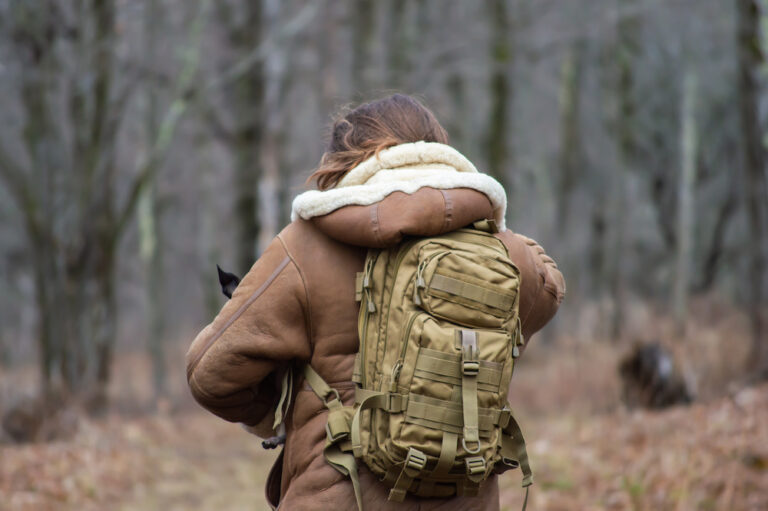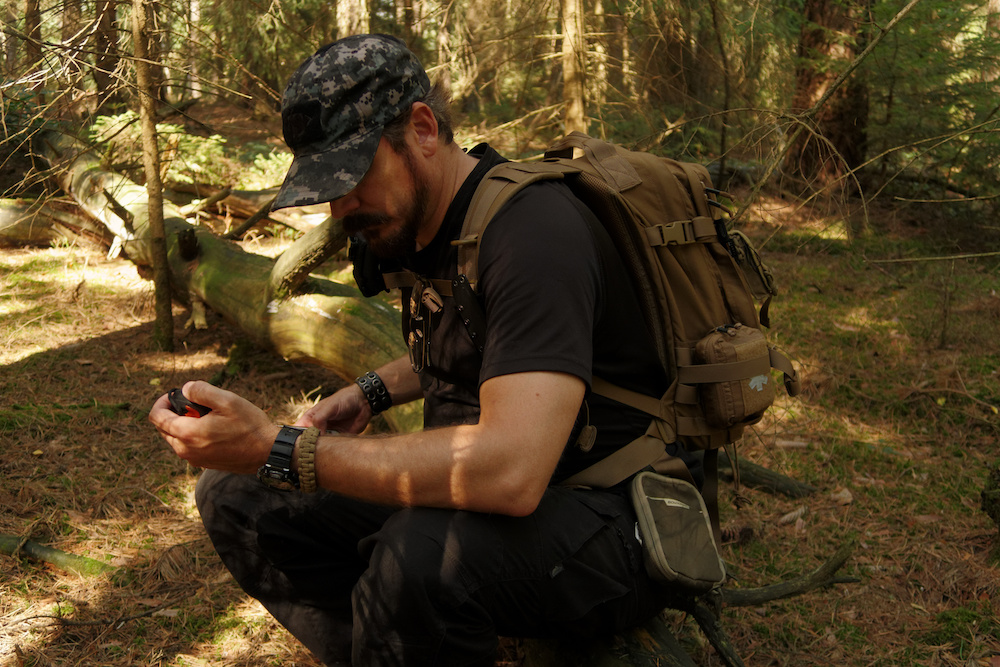Signup for our monthly newsletter and get your FREE "Tactical Gear" Guide
What Is a Tactical Backpack?
- Home
- Tactical Backpacks Advice
- What Is a Tactical Backpack

This site contains affiliate links to products. We may receive a commission for purchases made through these links.
If you need an upgrade from your standard bag, a tactical backpack is a fantastic option.
But what is a tactical backpack, anyway?
To understand what it is, it’s important to consider the significant benefits it brings to the wearer.
You’ve likely seen it before in your favorite war or spy movies, but it is also highly adaptable to real-life situations.
Table of Contents
What Backpacks Do the Military Use?
What Backpacks Do Navy SEALs Use?
What Should I Look For in a Tactical Backpack?
What Is a Tactical Backpack?
The basic definition of a tactical backpack is a bag designed to prepare you for tactical situations.
It will often have unique storage options, plenty of organizational solutions, and a lot of interior space.
During manufacturing, designers consider what servicemen and women require for their day-to-day operations.
Some backpacks have conveniences like CCW pockets, while others have built-in hydration pockets for water bladders.
With one, you can guarantee you’ll have far more storage than in a standard backpack, especially if you choose specific designs.
That said, tactical bags can also be useful for everyday people if you’ve found your regular bag isn’t enough.
You can quickly pack all of your essentials for commuting to work or school or for overnight trips.
Alternatively, the same backpack can double as a life-saving kit containing essential survival equipment.
It’s quite popular among survivalists as a bug-out bag, too.
What Backpacks Do the Military Use?
There are three primary types of military backpacks you’ll see: EDC, 24-hour, and three-day bags.
EDC (Everyday Carry) Bags
Everyday-carry bags are the ideal option for commuting and day trips.
They are the most similar in style to traditional backpacks, as they are around the same size.
They will also have some of the same features as the more extensive options but are designed for your essentials.
Typically, you should be able to pack everything you’d need for eight to 12 hours of travel.
These items include extra food, a flashlight, a water bottle, and a different shirt or two.
Most of these styles are likely to range between five and 35 liters in total storage.
24 - Hour Bags
24-hour backpacks are another alternative that is slightly larger than EDC bags.
As the name suggests, you’ll have enough space to carry items you’ll need for an entire 24 hours, including a spare change of clothes.
Most outdoor enthusiasts might find plenty of space for a quick hike rather than an expedition.
Out of the three options, you could consider 24-hour backpacks as a midsize option comfortable enough to carry.
You’ll also have up to 40 liters of interior and exterior storage to take advantage of.
We’ve found these models are most likely to contain all of the features you’d expect from a tactical backpack.
Three - Day Bags
As the largest option of the three, three-day backpacks are ideal for longer trips over extended distances.
They are a fantastic option for weekend-long hunts or week-long camping trips with solo equipment.
It’s also important to note that they have a significantly larger size than the other two variations.
Three-day bags are more expensive and will have greater attention to detail, especially regarding ruggedness.
It’s doubtful you’ll see significant wear and tear after several uses due to their improved quality.
However, they need to be packed carefully to ensure the bag’s weight is evenly distributed as they are larger.
What Backpacks Do Navy SEALs Use?
Navy SEALs are most likely to use three-day bags or 24-hour bags. The choice would likely depend on the length of their mission.
Three-day bags give them more than enough space for specialized equipment and other essential types of gear.
24-hour bags are also beneficial, as they’re lightweight and allow for better stealth than their larger alternatives.

What Should I Look For in a Tactical Backpack?
One of the best ways to understand what a tactical backpack offers is to compare it to standard bags.
You’ll notice a significant number of differences, which is why tactical versions often carry a higher price.
1. Storage
First and foremost, the most noticeable difference between these two types of bags is their available storage.
Tactical bags are specifically designed to give you enough space to carry your necessities for multiple days.
Some designs are best for 24-hour trips, while others have enough storage for up to seven days.
You’ll also find a larger-sized interior compartment as well as front-facing and side compartments.
Often, in the smaller compartments, there will be organizational tools, such as zippered mesh pockets.
You’re also likely to find pen organizers and document holders in the smaller pockets.
2. MOLLE Systems
Another considerable difference between the two styles is the MOLLE system.
This design choice is likely one of the most iconic features of tactical backpacks, especially for those in the service.
MOLLE systems are unique straps on the backpack’s exterior that allow you to clip on extra accessories.
Using D-rings and other MOLLE-compatible utilities, you can carry more essentials on the outside of your bag.
Users will often purchase individual pouches to store small pieces of gear, such as extra ammo and batteries.
One of MOLLE systems’ best features is its exterior storage, so the pouches are easily accessible.
Also, it helps you organize your gear more efficiently so that you can have customized organization.
3. Materials
Another area where these two types of bags differ is in the materials they bring to the table.
Most standard backpacks are made of nylon or polyester, while tactical bags are slightly more reliable.
They are more likely made of Cordura, ballistic nylon, or ripstop fabric.
Cordura
The most impressive feature of Cordura is that it is resistant to tears, abrasions, and scuffing.
It is also one of the United States military’s prized materials for over 45 years because of its ruggedness.
Cordura is frequently used in backpacks, jackets, footwear, and combat clothing.
Ballistic Nylon
Ballistic nylon was initially used in World War II flak jackets, which speaks to its versatility and wearability.
It is an incredibly resilient material that elevates the comfort and breathability of nylon to another level.
The great thing about it is that it is more lightweight than Cordura but offers an equal amount of protection.
Ripstop
Ripstop fabrics can come in many variations, whether it be ripstop polyester or nylon.
As the name suggests, it is designed to prevent rips and tears in your gear.
However, it is not as resilient as Cordura or ballistic nylon.
4. Strap Design
More often than not, the straps of traditional backpacks tend to lack comfort for all-day carrying.
On the other hand, tactical bags are specifically designed for long treks, especially the three-day backpacks.
They have more intuitively and ergonomically designed straps that help to reduce shoulder and back tension.
As a result, most people will be able to carry their backpacks for days on end without feeling excessive fatigue.
The strap design on tactical backpacks is imperative to ensure you don’t experience injuries while hiking.
5. Compression Systems
You’ll likely be carrying a lot of items with you in your tactical backpack.
This point is where compression systems come in handy, as they help reduce your bag’s overall size.
You can carry the same number of items, but you can reduce your bag’s thickness with compression technology.
This feature is ideal for creating a more streamlined backpack that is easy to use, even while navigating through rough terrain.
Also, it helps reduce the overall size of your bag, so it’s easier to pack for overseas travel.
6. CCW Pockets
Another iconic feature of tactical bags is that they have CCW pockets, perfect for self-defense.
Instead of wearing a holster or carrying your gun on your body, you use these specialized pockets.
CCW compartments are explicitly designed to hold full or midsize firearms safely and securely.
In some backpacks, you’ll be able to access your weapon easily if needed, while others are designed solely for storage.
Whether you’re hunting, camping in the wilderness, or in an active-duty scenario, these backpacks are handy.
7. Added Supports
The last feature that makes these backpacks unique is that they have added supports, similar to hiking bags.
As mentioned, your tactical bag is likely to be heavier because you’ll be carrying more items.
Typically, you’ll find an integrated chest strap as well as a waist belt to help manage your bag’s load.
Instead of carrying most weight on your shoulders, the chest and waist straps work together for added stability.
Not only does this help with ergonomics, but it can also make the bag more comfortable to manage in tight spaces.
You can guarantee that after several-hundred paces, you’ll notice a significant difference.
What’s Inside Tactical Backpacks?
Now that you have a clear idea of what classifies a backpack as tactical, let’s take a peek inside.
In this way, you’ll be able to decide how you can use the bag’s several key items to your advantage.
1. Frames
It’s expected that you’ll pack essential survival gear in your tactical bag, so you’ll find that they have more structure.
One of the most important features contributing to their structure is the framework for the bag.
Most options have either frame sheets, an internal frame, or an external structure on the more extensive options.
Frame Sheets
Frame sheets are the most common and are a thin piece of plastic inserted in the backpack’s rear lining.
Their sole purpose is to help the bag maintain its shape when it’s full without interfering with your comfort.
You’ll also find that this feature makes it more comfortable to carry more items than usual.
Internal Frame
As a step up, internal frames are typically made from aluminum rods, also known as stays.
The stays are built into the lining of the backpack and will be attached to the hip belt.
The most considerable advantage of an internal frame is it helps distribute weight across the bag evenly.
Instead of your back and shoulder bearing the brunt of the weight, the frame will also include your hips.
You’re most likely to find an internal frame in midsize tactical bags where a frame sheet isn’t sufficient.
External Frame
The most impressive option for load distribution is an external frame.
However, it is also one of the least common choices for modern tactical bags because it can be bulky and challenging to manage.
With the frame on the outside, it would be easy to snag your bag on the terrain.
However, they add extra storage to your pack, as you can carry additional items hung off the frame.
2. Loading Straps
As you can tell, the primary objective of tactical backpacks is to offer ample storage.
Loading straps are another feature you can use to your advantage to store larger items.
Typically, you can find front-, bottom-, or side-loading straps depending on the style you choose.
Front- and bottom-loading straps are on the backpack’s rear and give you space to keep a blanket or sleeping bag.
It’s also the best place to keep your rain gear secure but still easy to access.
Side-loading straps are equally as useful, especially when it comes to firearms.
Instead of having a CCW compartment, you can use a side-loading strap to secure your weapon.
This feature ensures you have easy access to your firearm if needed.
3. Extra Compartments
There are plenty of other areas to keep your belongings apart from the primary and exterior compartments.
Tactical backpacks are also known to feature valuables pockets, mesh pockets, and laptop sleeves.
Some of the higher-end designs will feature Velcro fields, where you can affix Velcro identification patches.
Valuable pockets are ideal for storing your smartphone, sunglasses, keys, and other small and expensive items.
They’ll often be lined with fleece to ensure the items don’t get scratched or damaged.
Another option for small valuables is mesh pockets, which could be zippered or elastic.
People will often use mesh pockets for pens and other trinkets, although they can be useful for water bottles.
If you don’t have a hydration pocket, you’ll surely need mesh pockets.
You’re also likely to find a laptop sleeve in a tactical backpack specifically designed for electronics.
The bags will often pair the laptop sleeve with a strap to ensure the device doesn’t shift in transit.
It will also boast plenty of padding to protect your laptop from other items in the main compartment.
4. Hydration Pockets
Also known as hydration bladder compartments, these pockets are exceptional features for preventing heat stress.
When carrying a heavy load, the last thing you want to deal with is an insulated water bottle.
As an alternative, water bladders help give you regular access to water in a hands-free manner.
Rather than having to stop and open a bottle of water, you can grab a hose attached to a bladder in your backpack.
This feature is by far one of the most used parts of a tactical backpack, especially for military personnel.
With easy-access hands-free water, you can ensure you’re never dehydrated.
Are Tactical Backpacks Worth It?
When figuring out what is a tactical backpack, you need to consider storage, materials, and versatility.
These bags help you make the most out of your travels by offering premium organizational elements.
They are also highly recommended for outdoor adventures, thanks to their military-ready components.

